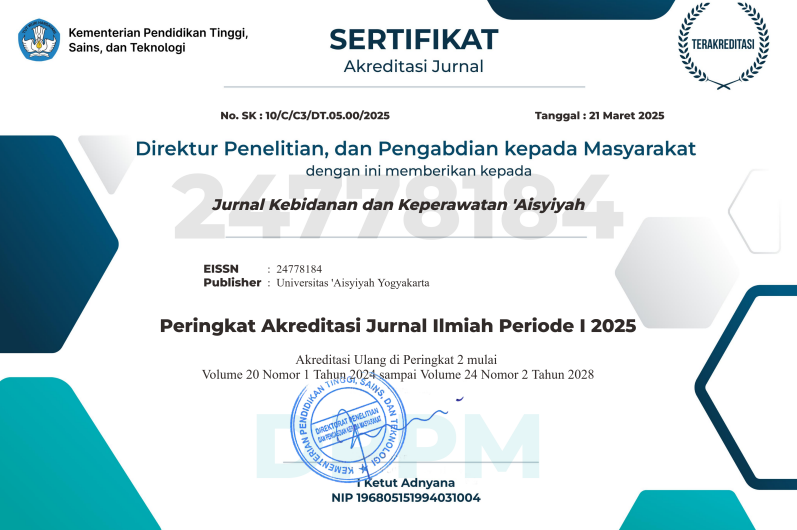Using prevention guidance of common physiological symptoms in pregnancy: a qualitative study
DOI:
https://doi.org/10.31101/jkk.3403Abstract views 812 times
Keywords:
common complaints; complaints in pregnancy; prenatal education; qualitative studyAbstract
Downloads
References
Afshar, A., & Tabrizi, A. (2021). Pregnancy-related hand and wrist problems. PubMed, 9(3), 345–349. https://doi.org/10.22038/abjs.2020.50995.2531
Ali, R. A. R., Hassan, J., & Egan, L. J. (2022). Review of recent evidence on the management of heartburn in pregnant and breastfeeding women. BMC Gastroenterology, 22(1), 219. https://doi.org/10.1186/s12876-022-02287-w
Asih, F. R., Danti, R. R., & Winarna, N. B. A. (2023). A Non-Randomized Controlled Trial of Prevention Guidance of Common Physiological Symptoms in Pregnancy for Self-Efficacy in Pregnant Women. Jurnal Aisyah : Jurnal Ilmu Kesehatan, 8(4). https://doi.org/10.30604/jika.v8i4.2516
Bai, G., Korfage, I. J., Groen, E. H., Jaddoe, V. W. V., Mautner, E., & Raat, H. (2016). Associations between Nausea, Vomiting, Fatigue and Health-Related Quality of Life of Women in Early Pregnancy: The Generation R Study. PLOS ONE, 11(11), e0166133. https://doi.org/10.1371/journal.pone.0166133
Balık, G., Sabri Balık, M., Ustüner, I., Kağıtcı, M., Sahin, F. K., & Güven, E. S. G. (2014). Hand and wrist complaints in pregnancy. Archives of Gynecology and Obstetrics, 290(3), 479–483. https://doi.org/10.1007/s00404-014-3244-2
Bjelke, M., Martinsson, A.-K., Lendahls, L., & Oscarsson, M. (2016). Using the Internet as a source of information during pregnancy—A descriptive cross-sectional study in Sweden. Midwifery, 40, 187–191. https://doi.org/10.1016/j.midw.2016.06.020
Bogaerts, A., Ameye, L., Bijlholt, M., Amuli, K., Heynickx, D., & Devlieger, R. (2017). INTER-ACT: Prevention of pregnancy complications through an e-health driven interpregnancy lifestyle intervention – study protocol of a multicentre randomised controlled trial. BMC Pregnancy and Childbirth, 17(1), 154. https://doi.org/10.1186/s12884-017-1336-2
Boutib, A., Chergaoui, S., Marfak, A., Hilali, A., & Youlyouz-Marfak, I. (2022). Quality of Life During Pregnancy from 2011 to 2021: Systematic Review. International Journal of Women’s Health, 14, 975–1005. https://doi.org/10.2147/IJWH.S361643
Bowman, R. L., Davis, D. L., Ferguson, S., & Taylor, J. (2018). Women’s motivation, perception and experience of complementary and alternative medicine in pregnancy: A meta-synthesis. Midwifery, 59, 81–87. https://doi.org/10.1016/j.midw.2017.11.007
Brekke, I., Richardsen, K. R., & Jenum, A. K. (2019). Sickness absence in pregnancy and sedentary behavior: A population-based cohort study from Norway. BMC Public Health, 19(1), 71. https://doi.org/10.1186/s12889-018-6379-4
Carvalho, M. E. C. C., Lima, L. C., de Lira Terceiro, C. A., Pinto, D. R. L., Silva, M. N., Cozer, G. A., & Couceiro, T. C. de M. (2017). Low back pain during pregnancy. Brazilian Journal of Anesthesiology, 67(3), 266–270. https://doi.org/10.1016/j.bjan.2016.03.002
Chauhan, A., & Potdar, J. (2022). Maternal Mental Health During Pregnancy: A Critical Review. Cureus, 14(10), e30656. https://doi.org/10.7759/cureus.30656
Erchick, D. J., Rai, B., Agrawal, N. K., Khatry, S. K., Katz, J., LeClerq, S. C., Reynolds, M. A., & Mullany, L. C. (2019). Oral hygiene, prevalence of gingivitis, and associated risk factors among pregnant women in Sarlahi District, Nepal. BMC Oral Health, 19(1), 2. https://doi.org/10.1186/s12903-018-0681-5
Ertmann, R. K., Nicolaisdottir, D. R., Kragstrup, J., Siersma, V., & Lutterodt, M. C. (2020). Sleep complaints in early pregnancy. A cross-sectional study among women attending prenatal care in general practice. BMC Pregnancy and Childbirth, 20(1), 123. https://doi.org/10.1186/s12884-020-2813-6
Feeley, T. H., Keller, M., & Kayler, L. (2023). Using Animated Videos to Increase Patient Knowledge: A Meta-Analytic Review. Health Education & Behavior: The Official Publication of the Society for Public Health Education, 50(2), 240–249. https://doi.org/10.1177/10901981221116791
Felder, J. N., Baer, R. J., Rand, L., Jelliffe-Pawlowski, L. L., & Prather, A. A. (2017). Sleep Disorder Diagnosis During Pregnancy and Risk of Preterm Birth. Obstetrics & Gynecology, 130(3), 573. https://doi.org/10.1097/AOG.0000000000002132
Hall, H. G., Griffiths, D., & McKenna, L. G. (2015). Complementary and alternative medicine: Interaction and communication between midwives and women. Women and Birth: Journal of the Australian College of Midwives, 28(2), 137–142. https://doi.org/10.1016/j.wombi.2014.12.003
Hall, H. R., & Jolly, K. (2014). Women’s use of complementary and alternative medicines during pregnancy: A cross-sectional study. Midwifery, 30(5), 499–505. https://doi.org/10.1016/j.midw.2013.06.001
Hamzehei, R., Kazerani, M., Shekofteh, M., & Karami, M. (2018). Online Health Information Seeking Behavior among Iranian Pregnant Women: A Case Study.
Haney, A., Buysse, D. J., Rosario, B. L., Chen, Y.-F., & Okun, M. L. (2014). Sleep disturbance and cardiometabolic risk factors in early pregnancy: A preliminary study. Sleep Medicine, 15(4), 444–450. https://doi.org/10.1016/j.sleep.2014.01.003
Harpel, T. (2018). Pregnant Women Sharing Pregnancy-Related Information on Facebook: Web-Based Survey Study. Journal of Medical Internet Research, 20(3), e115. https://doi.org/10.2196/jmir.7753
Hashmi, N., Ullah, I., El Hayek, S., & Shakoor, N. (2020). The impact of the COVID-19 pandemic on mental health and service delivery during pregnancy: Role of telepsychiatry. Asian Journal of Psychiatry, 54, 102461. https://doi.org/10.1016/j.ajp.2020.102461
Hay, S. J., McLachlan, H. L., Newton, M., Forster, D. A., & Shafiei, T. (2022). Sources of information during pregnancy and the early parenting period: Exploring the views of women and their partners. Midwifery, 105, 103236. https://doi.org/10.1016/j.midw.2021.103236
Hong, K., Hwang, H., Han, H., Chae, J., Choi, J., Jeong, Y., Lee, J., & Lee, K. J. (2021). Perspectives on antenatal education associated with pregnancy outcomes: Systematic review and meta-analysis. Women and Birth: Journal of the Australian College of Midwives, 34(3), 219–230. https://doi.org/10.1016/j.wombi.2020.04.002
Ilankoon, P., Goonewardena, C., Fernandopulle, R., & Perera, P. P. R. (2018). Women’s understanding and cultural practices related to vaginal discharge: A qualitative study. Nursing and Midwifery Studies, 7, 74. https://doi.org/10.4103/nms.nms_60_17
Jacobs, E. J. A., van Steijn, M. E., & van Pampus, M. G. (2019). Internet usage of women attempting pregnancy and pregnant women in the Netherlands. Sexual & Reproductive Healthcare, 21, 9–14. https://doi.org/10.1016/j.srhc.2019.04.005
Javanmardi, M., Noroozi, M., Mostafavi, F., & Ashrafi-rizi, H. (2019). Challenges to access health information during pregnancy in Iran: A qualitative study from the perspective of pregnant women, midwives and obstetricians. Reproductive Health, 16(1), 128. https://doi.org/10.1186/s12978-019-0789-3
Javanmardi, M., Noroozi, M., Mostafavi, F., & Ashrafi-Rizi, H. (2020). Exploring Women’s Health Information Needs During Pregnancy: A Qualitative Study. Journal of Family & Reproductive Health, 14(4), 252–258. https://doi.org/10.18502/jfrh.v14i4.5209
Kazemi, F., Nahidi, F., & Kariman, N. (2017). Disorders Affecting Quality of Life During Pregnancy: A Qualitative Study. Journal of Clinical and Diagnostic Research : JCDR, 11(4), QC06-QC10. https://doi.org/10.7860/JCDR/2017/23703.9560
Kennedy, R. A. K., Mullaney, L., Reynolds, C. M. E., Cawley, S., McCartney, D. M. A., & Turner, M. J. (2017). Preferences of women for web-based nutritional information in pregnancy. Public Health, 143, 71–77. https://doi.org/10.1016/j.puhe.2016.10.028
Khoramabadi, M., Dolatian, M., Hajian, S., Zamanian, M., Taheripanah, R., Sheikhan, Z., Mahmoodi, Z., & Seyedi-Moghadam, A. (2016). Effects of Education Based on Health Belief Model on Dietary Behaviors of Iranian Pregnant Women. Global Journal of Health Science, 8(2), 230–239. https://doi.org/10.5539/gjhs.v8n2p230
Kiftia, M., Rizkia, M., Ardhia, D., & Darmawati. (2022). The correlation among pregnant woman’s education level with knowledge and behaviour on readiness toward COVID-19 pandemic. Enfermeria Clinica, 32, S35–S38. https://doi.org/10.1016/j.enfcli.2022.03.014
Lagadec, N., Steinecker, M., Kapassi, A., Magnier, A. M., Chastang, J., Robert, S., Gaouaou, N., & Ibanez, G. (2018). Factors influencing the quality of life of pregnant women: A systematic review. BMC Pregnancy and Childbirth, 18(1), 455. https://doi.org/10.1186/s12884-018-2087-4
Li, R., Zhang, J., Zhou, R., Liu, J., Dai, Z., Liu, D., Wang, Y., Zhang, H., Li, Y., & Zeng, G. (2017). Sleep disturbances during pregnancy are associated with cesarean delivery and preterm birth. The Journal of Maternal-Fetal & Neonatal Medicine, 30(6), 733–738. https://doi.org/10.1080/14767058.2016.1183637
Liu, J., Song, G., Zhao, G., & Meng, T. (2021). Effect of oral magnesium supplementation for relieving leg cramps during pregnancy: A meta-analysis of randomized controlled trials. Taiwanese Journal of Obstetrics & Gynecology, 60(4), 609–614. https://doi.org/10.1016/j.tjog.2021.05.006
MacGibbon, K., & Mullin, P. (2015). Mortality Secondary to Hyperemesis Gravidarum: A Case Report. Women’s Health & Gynecology, 1(2).
Malmqvist, S., Kjaermann, I., Andersen, K., Økland, I., Larsen, J. P., & Brønnick, K. (2015). The association between pelvic girdle pain and sick leave during pregnancy; a retrospective study of a Norwegian population. BMC Pregnancy and Childbirth, 15(1), 237. https://doi.org/10.1186/s12884-015-0667-0
Manyozo, S. D., Nesto, T., Bonongwe, P., & Muula, A. S. (2019). Low back pain during pregnancy: Prevalence, risk factors and association with daily activities among pregnant women in urban
Blantyre, Malawi. Malawi Medical Journal, 31(1), 71–76. https://doi.org/10.4314/mmj.v31i1.12
McCarthy, R., Byrne, G., Brettle, A., Choucri, L., Ormandy, P., & Chatwin, J. (2020). Midwife-moderated social media groups as a validated information source for women during pregnancy. Midwifery, 88, 102710. https://doi.org/10.1016/j.midw.2020.102710
Moe-Byrne, T., Evans, E., Benhebil, N., & Knapp, P. (2022). The effectiveness of video animations as information tools for patients and the general public: A systematic review. Frontiers in Digital Health, 4, 1010779. https://doi.org/10.3389/fdgth.2022.1010779
Narasimhulu, D. M., Karakash, S., Weedon, J., & Minkoff, H. (2016). Patterns of Internet Use by Pregnant Women, and Reliability of Pregnancy-Related Searches. Maternal and Child Health Journal, 20(12), 2502–2509. https://doi.org/10.1007/s10995-016-2075-0
Nintao, N., Manonai, J., Wattanayingcharoenchai, R., Bumrungphuet, S., Hansahiranwadee, W., Dulyaphat, W., Somchit, W., Wattanasirichaigoon, D., Prakobpanich, M., & Tangshewinsirikul, C. (2023). Effects of an animated educational video on knowledge of cell-free DNA screening among Thai pregnant women: A randomized control trial. BMC Pregnancy and Childbirth, 23(1), 853. https://doi.org/10.1186/s12884-023-06170-8
Praveena. (2022). Application of Colaizzi’s Method of Data Analysis in Phenomenological Research. Medico Legal Update, 21. https://doi.org/10.37506/mlu.v21i2.2800
Pushpaven. (2018). Effectiveness of video Assisted Instructional Module on Antenatal Care on the Pregnancy outcome of pregnant women attending Maternity Hospitals, Bangalore. Asian Journal of Nursing Education and Research, 8(4). https://doi.org/10.5958/2349-2996.2018.00103.9
Rao, V. L., & Mahmood, T. (2020). Vaginal discharge. Obstetrics, Gynaecology and Reproductive Medicine, 30(1), 11–18. https://doi.org/10.1016/j.ogrm.2019.10.004
Rudder, M., Lefkowitz, E. G., Ruhama, T., & Firoz, E. (2021). A review of pruritus in pregnancy. Obstetric Medicine, 14(4), 204–210. https://doi.org/10.1177/1753495X20985366
Salari, N., Darvishi, N., Khaledi-Paveh, B., Vaisi-Raygani, A., Jalali, R., Daneshkhah, A., Bartina, Y., & Mohammadi, M. (2021). A systematic review and meta-analysis of prevalence of insomnia in the third trimester of pregnancy. BMC Pregnancy and Childbirth, 21(1), 284. https://doi.org/10.1186/s12884-021-03755-z
Salari, N., Mohammadi, A., Hemmati, M., Hasheminezhad, R., Kani, S., Shohaimi, S., & Mohammadi, M. (2023). The global prevalence of low back pain in pregnancy: A comprehensive systematic review and meta-analysis. BMC Pregnancy and Childbirth, 23(1), 830. https://doi.org/10.1186/s12884-023-06151-x
Sayakhot, P., & Carolan-Olah, M. (2016). Internet use by pregnant women seeking pregnancy-related information: A systematic review. BMC Pregnancy and Childbirth, 16(1), 65. https://doi.org/10.1186/s12884-016-0856-5
Sedov, I. D., Anderson, N. J., Dhillon, A. K., & Tomfohr-Madsen, L. M. (2021). Insomnia symptoms during pregnancy: A meta-analysis. Journal of Sleep Research, 30(1), e13207. https://doi.org/10.1111/jsr.13207
Serçekuş, P., & Başkale, H. (2016). Effects of antenatal education on fear of childbirth, maternal self-efficacy and parental attachment. Midwifery, 34, 166–172. https://doi.org/10.1016/j.midw.2015.11.016
Shahry, P., Kalhori, S. R. N., Esfandiyari, A., & Zamani-Alavijeh, F. (2016). A Comparative Study of Perceived Social Support and Self-Efficacy among Women with Wanted and Unwanted Pregnancy. International Journal of Community Based Nursing and Midwifery, 4(2), 176–185.
Silvestri, R., & Aricò, I. (2019). Sleep disorders in pregnancy. Sleep Science, 12(3), 232–239. https://doi.org/10.5935/1984-0063.20190098
Smyka, M., Kosińska-Kaczyńska, K., Sochacki-Wójcicka, N., Zgliczyńska, M., & Wielgoś, M. (2020). Sleep Problems in Pregnancy—A Cross-Sectional Study in over 7000 Pregnant Women in Poland. International Journal of Environmental Research and Public Health, 17(15), 5306. https://doi.org/10.3390/ijerph17155306
Tinti, S., Praticò, F., Bonaldo, V., Rovetto, M. Y., Barattini, D. F., Casolati, E., Piccolo, E., Piazza, R., Liberati, M., Locci, M., & Cetin, I. (2023). Prevalence and burden of nausea and vomiting in pregnant women: Interim analysis of the PURITY survey. European Journal of Obstetrics & Gynecology and Reproductive Biology, 290, 135–142. https://doi.org/10.1016/j.ejogrb.2023.09.016
Truong, B. T., Lupattelli, A., Kristensen, P., & Nordeng, H. (2017). Sick leave and medication use in pregnancy: A European web-based study. BMJ Open, 7(8), e014934. https://doi.org/10.1136/bmjopen-2016-014934
Turkdogan, S., Roy, C. F., Chartier, G., Payne, R., Mlynarek, A., Forest, V.-I., & Hier, M. (2022). Effect of Perioperative Patient Education via Animated Videos in Patients Undergoing Head and Neck Surgery: A Randomized Clinical Trial. JAMA Otolaryngology–Head & Neck Surgery, 148(2), 173–179. https://doi.org/10.1001/jamaoto.2021.3765
Vogels-Broeke, M., Daemers, D., Budé, L., de Vries, R., & Nieuwenhuijze, M. (2022). Sources of information used by women during pregnancy and the perceived quality. BMC Pregnancy and Childbirth, 22(1), 109. https://doi.org/10.1186/s12884-022-04422-7
von Glehn, M. de P., Sidon, L. U., & Machado, E. R. (2017). Gynecological complaints and their associated factors among women in a family health-care clinic. Journal of Family Medicine and Primary Care, 6(1), 88. https://doi.org/10.4103/2249-4863.214982
World Health Organization. (2016). WHO recommendations on antenatal care for a positive pregnancy experience. World Health Organization. https://iris.who.int/handle/10665/250796
Yikar, S. K., & Nazik, E. (2019). Effects of prenatal education on complaints during pregnancy and on quality of life. Patient Education and Counseling, 102(1), 119–125. https://doi.org/10.1016/j.pec.2018.08.023
Zhong, B.-L., Luo, W., Li, H.-M., Zhang, Q.-Q., Liu, X.-G., Li, W.-T., & Li, Y. (2020). Knowledge, attitudes, and practices towards COVID-19 among Chinese residents during the rapid rise period of the COVID-19 outbreak: A quick online cross-sectional survey. International Journal of Biological Sciences, 16(10), 1745–1752. https://doi.org/10.7150/ijbs.45221
Zhu, C., Zeng, R., Zhang, W., Evans, R., & He, R. (2019). Pregnancy-Related Information Seeking and Sharing in the Social Media Era Among Expectant Mothers: Qualitative Study. Journal of Medical Internet Research, 21(12), e13694. https://doi.org/10.2196/13694
Downloads
Published
How to Cite
Issue
Section
License
Copyright (c) 2024 Jurnal Kebidanan dan Keperawatan Aisyiyah

This work is licensed under a Creative Commons Attribution-ShareAlike 4.0 International License.
With the receipt of the article by the Jurnal Kebidanan dan Keperawatan Aisyiyah Editorial Board and the decision to be published, then the copyright regarding the article will be diverted to Jurnal Kebidanan dan Keperawatan Aisyiyah. Universitas 'Aisyiyah Yogyakarta as the publisher of Jurnal Kebidanan dan Keperawatan Aisyiyah hold the copyright regarding all the published articles in this journal.
Jurnal Kebidanan dan Keperawatan Aisyiyah is licensed under a Creative Commons Attribution-ShareAlike 4.0 International License.
















